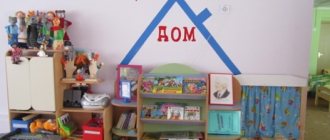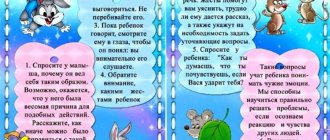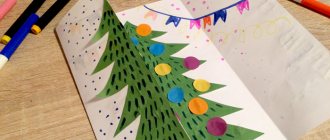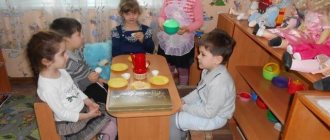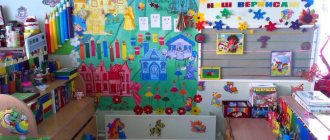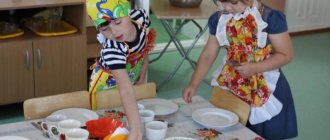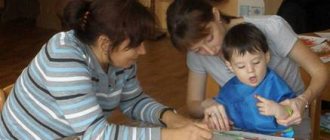Developmental gaming environment in an early age group according to the Federal State Educational Standard
Organization of a developing gaming environment in the context of the requirements of the Federal State Educational Standard for preschool education (from work experience)
The innovative nature of the Federal State Educational Standard of preschool education is expressed in such concepts as socialization, individualization of development and support for children's initiative.
These are three core tasks, around the solution of which the content of modern preschool education is built [1, p.4]. When organizing a developmental play environment in our group, where young children go, we took into account the Federal State Educational Standard for Educational Education and were guided by provisions that describe the situation of child development, including three groups of conditions: - spatiotemporal (play space, toys, furniture), - social ( system of relationships with peers and adults), - activity (motor, play, communicative, visual activities, construction, perception of fiction and folklore). According to the Federal State Educational Standard for Educational Education, a developmental environment is a certain ordered educational space in which learning takes place [1, p. 5]. Properly organized, it helps an adult ensure the harmonious development of the child, create an emotionally positive atmosphere in the group, organize and conduct games and activities, and thus teach children to play independently. Our group has created conditions for the development and learning of young children. When selecting toys, we took into account pedagogical expediency, artistic acceptability, age interests of children, gender specificity, safety, hygiene, etc. Games and toys available in a group in sufficient quantities give children the opportunity to demonstrate small physical activity in the group, carry out object-based and play activities , development of fine motor skills against the background of the emotional component of interaction with adults and peers. Although in this article we have conditionally divided the didactic materials used in working with children into separate centers, in pedagogical practice we use the same material to solve different educational problems, thereby observing the principle of variability, integration and complementarity. We pay great attention to the development of motor activity, so we divided the center of motor activity into two parts. In one part there are large sports modules, such as a slide and a dry pool, and in the other part there is a “health track”, including massage mats. At the center of motor activity there are balls of different sizes, skittles, dumbbells, flags, rings with multi-colored ribbons, and hoops. There are technical toys: train, truck, dump truck; a car, rocking toys, cars that children can ride on their own. The nature of the object and play environment is associated with color, shape, size, orientation in space, etc. Therefore, the group contains pyramids, rods for stringing with colored elements of various shapes, a large floor pyramid, nesting dolls, sets of cubes and volumetric bodies, toys-tools ( scoops, spatulas with sets of molds, fishing rods, nets, scoops, rakes, hammers, etc.), sets of volumetric inserts, mosaics, insert frames, puzzles, construction sets. For experimentation, there is a special table with a tray, floating and sinking objects, plastic materials (clay), and tubes for inserting objects. The toys available in the group are made from materials of different qualities and different densities. To create an emotional component of interaction with adults and peers, there are toys with secrets and surprises, toys with light effects, a “magic bag,” soap bubbles, wind-up toys, fun toys, glove puppets, masks, etc. In the speech development center there are sets of subject and plot pictures on various topics. For visual reference, the group has a “carousel” on which pictures are hung. These pictures change once a quarter: according to the season and theme (toys, transport, Christmas decorations, etc.). In order for the child to have privacy, there is a doll corner in the group with stationary and tabletop doll furniture, tabletop “kitchen” sets, character toys, dolls of different sizes in clothes, naked dolls, anthropomorphic animals, etc. The mummers' corner is designed in the form of a hut, where there is a mirror and a chest with doll clothes. Multi-colored skirts, vests, scarves, shirts, and handbags hang on hangers. To develop children's hearing, in the music corner there are toy musical instruments (tambourines, drums, rattles, maracas, spoons, bells, pipes, metallophones), sound books, musical toys, audio equipment (tape recorder, audio materials with recordings of musical works). The theater center is represented by sets of dolls, fairy-tale characters, screens for puppet performances, costumes, masks, etc. There is a magnetic board, different types of theater (bibabo, tabletop, finger), and audio equipment. The group has an art center and a book corner. All of the listed games and aids are placed on shelves that are fixed at the height of children and are available for use. Thus, when organizing a developmental gaming environment, we put the tasks of the psychological and emotional well-being of children, providing opportunities for communication, joint activities of adults and children, and physical activity at the forefront. We believe that the educational gaming environment in our group meets the requirements of the Federal State Educational Standard for Education. Literature: 1. Sleptsova, I. Features of the organization of a developmental gaming environment in the context of the requirements of the Federal State Educational Standard for preschool education / I. Sleptsova // Preschool education. – 2017. – No. 2. – P.4-8.
We recommend watching:
Summary of entertaining activities in kindergarten. Junior group Planned results of mastering the program in the junior group according to the Federal State Educational Standards Features of the development of children of primary preschool age Age characteristics of children 3-4 years old according to the Federal State Educational Standard briefly
Similar articles:
Organization of a walk in the junior group according to the Federal State Educational Standard
Observations of wildlife in the younger group of kindergarten
Observations of inanimate nature on a walk in the younger group
Observations of the work of adults in the younger group
Observations of street life. Junior group
Subject-spatial environment in the second group of early age 2019-2020
Municipal budgetary preschool educational institution of a combined type, North Yenisei kindergarten No. 4 “Zharki”
Analysis of the developing subject-spatial environment
in the second early age group 2019-2020
Educator: Sagdatdinova R.I.
Relevance
The issue of organizing the subject-developmental environment of preschool educational institutions is particularly relevant today. This is due to the introduction of the new Federal State Educational Standard (FSES DO).
In the requirements of the Federal State Standard, the subject-spatial environment is designated as one of the key conditions for a successful educational process. And the creation of a subject-spatial developmental environment that meets the requirements of the Federal State Educational Standard is a key task of preschool organizations. The subject-spatial environment should stimulate children to be active in various types of activities and develop abilities. The developing subject-spatial environment of a preschool institution is an important component in the development of a child. The child’s activity depends on how the object-game organization of his life is structured.
"Subject development environment"
- this is a system of material objects of a child’s activity, the content of his spiritual and physical development, this is the unity of social and objective means.
A properly organized developmental environment in the group allowed each child to find something to their liking and to believe in their strengths and abilities. It is not the adult, but the objective world that encourages the child to take independent active actions.
According to the Federal State Educational Standard for preschool education, the content of the educational program must ensure the development of the personality, motivation and abilities of children in various types of activities and covers the following structural units, representing certain areas of development and education of children:
- Social and communicative development;
- Cognitive development;
- Speech development;
- Artistic and aesthetic development;
- Physical development.
The types of activities of preschool children within each educational area can be implemented based on the potential of the developing subject-spatial environment of the preschool educational institution with appropriate content.
In accordance with the principles discussed, the following subject-development environment was created in the second group of the Forget-Me-nots early age group:
Social and communicative development:
- Center for role-playing games “Play”;
- Solitude corner.
Cognitive development:
- center for educational games "Znayka";
- ;
- center for board and printed games “Pochemuchka”;
- .
Speech development:
- center for theatrical activities “Visiting a Fairy Tale”;
- Corner "Mumming".
Artistic and aesthetic development:
- .
Physical development:
- . Social and communicative development
:
- Center for role-playing games “Play”;
When creating an object-based play environment in a group, we take into account certain requirements: this is, first of all, the freedom for the child to achieve the theme and plot of the game.
Corner of solitude
- this is a means designed to facilitate the process of a child’s adaptation to a new team, walls, and daily routine. A corner of solitude is a place in a group where a child feels completely safe, where he can escape from stressful events.
Cognitive development:
- center for educational games "Znayka";
- ;
- center for board and printed games “Pochemuchka”;
- .
Center for educational games "Znayka".
The center for educational games is aimed at developing speech, sensory perception, fine motor skills, and imagination.
.
The “Water and Sand Center” in our group helps organize children’s cognitive and research activities. We are talking about playing and experimenting with various objects and natural materials. By organizing games with water and sand, we not only introduce children to the properties of various objects and materials, but also help them consolidate ideas about the shape, size, color of objects, develop fine motor skills, and lay the foundation for learning to design (molding from sand).
Center for board and printed games "Pochemuchka".
The play area contains a variety of games for children, taking into account age and gender education.
Goal: Development of fine and gross motor skills in children of the younger group. Sensory development is, first of all, the development of its perception and the formation of ideas about the external properties of objects: their shape, color, size, position in space.
Speech development:
- center for theatrical activities “Visiting a Fairy Tale”;
- Corner "Mumming".
Center for theatrical activities.
The Theater Activity Center is one of the active sectors in our group; its goal is: Development of creative abilities in children; Development of imagination, ability to improvise; Development of memory, attention, expression of basic emotions; Instill a sustainable interest in literature, theater, music; All costumes and attributes are arranged so that it is convenient for children to take them and use them, and they will unite in subgroups based on common interests. In the corner there are props for various types of theater: finger theater, tabletop, flat.
Corner "Mumming".
In our group there is a corner that all children, without exception, love. Everyone chooses their own image, according to their sympathies and feelings living in their soul here and now. This provides psycho-emotional release and lifts your spirits. They study the purpose of things and their seasonality. They choose their own image.
Equipment:
Mobile shelf cabinet for storing costumes, exhibition stand, screen, modules, masks, costumes, ribbons, capes, hats, scarves, bags, attributes for fairy tales.
Book Center.
The most accessible and effective way to develop children is reading. The educational potential of a children's book is limitless. Thinking, speech, memory, attention, imagination - all this is formed through communication with a book.
Equipment:
library of fiction, illustrations for works, subject and subject pictures, portraits of children's writers, didactic games
Artistic and aesthetic development:
.
The main goal of this center is to develop the creative abilities of preschool children.
Physical development.
One of the basic needs of early childhood is the need for movement. For this purpose, physical education equipment has been selected in the sports corner, which encourages children to be physically active and gives them the opportunity to diversify their movements. In the corner there are various materials: balls, hoops, multi-colored flags, ribbons, plumes. And bags filled with sand, peas, cereals, rings, massage paths are used for walking, stepping over, jumping. A variety of bright toys and objects are also used, which are an incentive to perform a variety of movements. The equipment corresponds to the age characteristics of children. The equipment is placed in such a way as to stimulate physical activity and encourage interesting and feasible actions.
Conclusion:
Thus, the developing object-spatial environment I created for young children, first of all, performs an informational function in relation to them; each object carries certain information about the world around them and becomes a means of transmitting social experience. Serves the interests and needs of the child, enriches the development of specific types of activities, provides the child’s zone of proximal development, encourages them to make conscious choices, put forward and implement their own initiatives, make independent decisions, develop creative abilities, and also shape the personal qualities of preschoolers and their life experience, i.e. e. ensures the full development of the child’s activity and personality.
Manager
MBDOU No. 4 “Zharki” _______________________ G.I. Lopateva
2
Principles of constructing a subject-spatial developmental environment in early age groups
The construction of a developmental space in a preschool educational institution is a natural necessity for organizing educational activities. It is necessary to meet the needs and interests of children in performing various types of activities. Its creation opens up the possibility of finding an activity that is interesting to a particular child, helps him find himself and establish interaction with others. At the same time, the child is given the right to independently choose the type of activity and methods of its implementation.
Are you an expert in this subject area? We invite you to become the author of the Directory Working Conditions
The construction of a subject-developmental environment for early age groups is based on specific principles that are associated with the developmental characteristics of a child of this age.
The basic principles of organizing the subject-developmental space of early age groups are the following:
- The principle of wide space. The child should have enough space to perform a wide variety of movements and implement various types of play activities. This is due to the poor development of motor coordination in young children. Therefore, equipment must be arranged in such a way as to maintain a wide space between it for children to move around.
- The principle of variability in filling the environment. It should include a large number of different subjects, objects, information focused on children’s activities and simplifying the adaptation period in a preschool educational institution.
- The principle of brightness and saturation of the environment. It is expected to use objects, furniture and other objects painted in bright colors. This creates a positive emotional background for a young child and motivates him to activity in this environment.
- The principle of aesthetic design. Aesthetics must be present in everything, starting from the design style, its unity and ending with the correspondence of the furnishings to its purpose.
- The principle of environmental transformability. It means the possibility of changing space in accordance with changes in the educational situation, interests and needs of children, as well as as they master new types of activities.
- The principle of multifunctionality of the environment. It means filling it with objects that can be used variably to achieve various educational goals and objectives. Environmental objects must be available for use by children in different types of their activities.
- The principle of stimulation. It means that the environment must be built in such a way as to stimulate the development of children's perception, activate the work of analyzers and form the basis of sensory development.
- The principle of accessibility. It means the child’s free access to the environment and any of its objects: games, toys, materials used in children’s activities. This principle underlies the construction of a developmental environment in all age groups.
- The principle of environmental security. All furniture and environmental objects must be safe for use by young children. And this involves the exclusion of small objects, sharp corners, and piercing objects.
Finished works on a similar topic
Course work Features of the organization of a subject-spatial developmental environment in an early age group 400 ₽ Abstract Features of the organization of a subject-spatial developmental environment in an early age group 230 ₽ Examination Features of the organization of a subject-spatial developmental environment in an early age group 220 ₽
Receive completed work or specialist advice on your educational project Find out the cost
